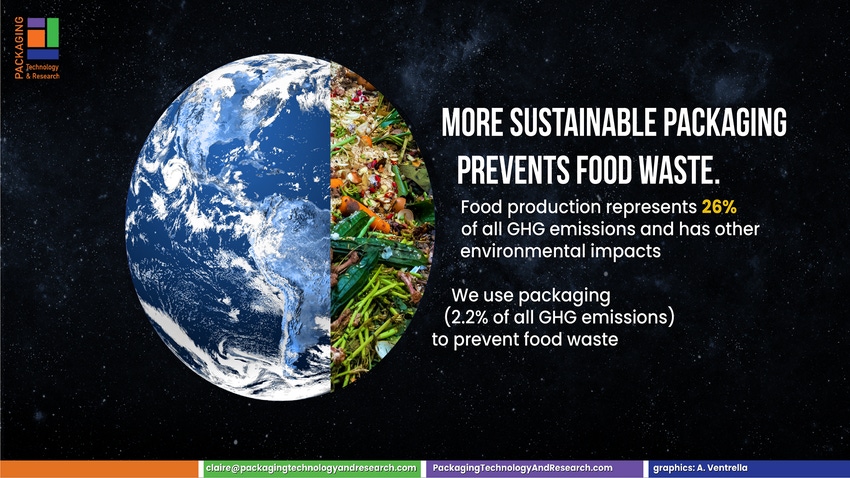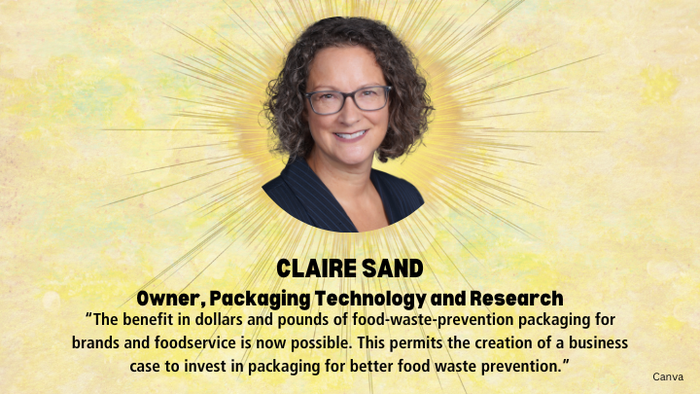Packaging Can Work Harder to Prevent Food Waste
With Earth Day Stop Food Waste this week, we consider how brands and stakeholders can leverage packaging to reduce food waste.
April 24, 2024

At a Glance
- Packaging is vital to preserve food, food security, and the environment.
- Packaging is key to prevent food waste, which is crucial for climate action.
- Collaboration drives innovative packaging to reduce food waste sustainably.
Food packaging has a unique role in protection. Protecting food from waste directly protects our natural resources — water, land, and air. Food packaging is also an indirect food additive, so we need to ensure it is safe for a safe food supply.
Food production accounts for 26% of total greenhouse gas emissions (GHG) and has additional environmental consequences.
However, we need food to survive! We employ packaging (which is only 2.2% of total GHG emissions) to prevent food waste, allowing us to enjoy the food we have spent resources to create.
Food waste per capita is increasing at an alarming 6% pace (Statista, 2016-2019). Better packaging can reduce food waste by 26% to 50%. So, by investing in packaging that is more effective in preventing food waste, we can reduce greenhouse gas emissions. The good news is that the government, brands, and retailers recognize the value in packaging that avoids food waste.

RICK LINGLE via CANVA
Government: A new EPA food waste scale showcases the benefit of focusing on food waste prevention rather than diverting food waste to animal feed or composting. This underlines the relevance of packaging in food waste avoidance. And, because five states — California, Connecticut, Massachusetts, Rhode Island, and Vermont — limit food waste to compost, land enhancements, anaerobic digestion, and diversion to animal feed, there will be a greater emphasis on food waste prevention…with packaging.
Retailers: We can prevent about 68% of retailer-derived food waste using better packaging. Retailers are shifting from donating food to food pantries. Why? There is too little shelf life left to reach needy clients.
The retail focus is now on optimizing food selection to reduce the labor in stocking and logistics associated with handling excess food. Instead, brands are donating straight to food pantries and producing food specific for food pantries. This is a more optimal process and allows for planning for food pantries and clients in need in addition to reducing retail-derived food waste.
Organization such as Champions 12.3’s 10x20x30 initiative focuses on 10 retailers engaging with 20 suppliers to halve food waste by 2030. Importantly, these retailers (AEON, Ahold Delhaize, Carrefour, IKEA Food, Kroger, Metro AG, Migros-Turkey, Pick n Pay, The Savola Group, Sodexo, Tesco, and Walmart) operate in more than 90 countries, including the USA. The derivation of the 12.3 designation came from the United Nations Strategic Development Goal Target 12.3, which links food waste and packaging and production.
Brands: The benefit in dollars and pounds of food-waste-prevention packaging for brands and foodservice is now possible. This permits the creation of a business case to invest in packaging for better food waste prevention. Importantly for brands, 26% to 50% of food waste can be prevented with better packaging, according to ReFED.
Investments in long-term innovations such as advanced active packaging, lower gauge barrier technology, and replacements for cold chains is fueled by brands.
Brands are driving investments in long-term technologies such as enhanced active packaging, lower gauge barrier technology, and cold chain replacement solutions. Bob’s Red Mill, Chick-fil-A, Del Monte Fresh Produce Company, Lamb Weston, joined the US Food Waste Pact. The Pact aligns with the Champions 12.3 methodology of “Target, Measure, Act” to aid meeting waste reduction goals. Examples of food waste prevention, include vacuum packaging and portioning for meat and recent data from Ameripen and AURI, indicate that this food waste prevention resonates with consumers. Specific applications in portioning through packaging and packaging machinery, for example MultiVac’s Compact portioning machine.
Reflecting on Earth Day and Save Food Day this week, we appear wonderfully poised to use packaging to sustainably prevent food waste.
About the Author(s)
You May Also Like




